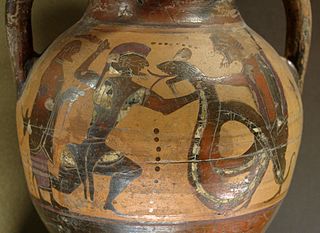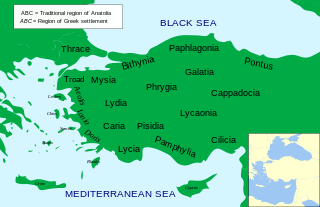
Strabo was a Greek geographer, philosopher, and historian who lived in Asia Minor during the transitional period of the Roman Republic into the Roman Empire.

According to Greek mythology, the Korybantes or Corybantes were the armed and crested dancers who worshipped the Phrygian goddess Cybele with drumming and dancing. They are also called the Kurbantes in Phrygia.

Paphlagonia was an ancient region on the Black Sea coast of north central Anatolia, situated between Bithynia to the west and Pontus to the east, and separated from Phrygia by a prolongation to the east of the Bithynian Olympus. According to Strabo, the river Parthenius formed the western limit of the region, and it was bounded on the east by the Halys River. Paphlagonia was said to be named after Paphlagon, a son of the mythical Phineus. The name may ultimately be derived from Pala, an Indo-European speaking people mentioned in Hittite texts that likely lived in this general area.

Philetaerus was the founder of the Attalid dynasty of Pergamon in Anatolia.

Makronisos, or Makronisi, is an island in the Aegean sea, in Greece, notorious as the site of a political prison from the 1920s to the 1970s. It is located close to the coast of Attica, facing the port of Lavrio. The island has an elongated shape, 13 km (8 mi) north to south and 2.5 km (1.6 mi) east to west at its widest point, and its terrain is arid and rocky. It is the largest uninhabited Greek island.
Polemon I Pythodoros was the Roman Client King of Cilicia, Pontus, Colchis and the Bosporan Kingdom. Polemon was the son and heir of Zenon and possibly Tryphaena. Zenon and Polemon adorned Laodicea with many dedicated offerings.
Siris was an ancient city of Magna Graecia, situated at the mouth of the river of the same name flowing into the Tarentine gulf, and now called the Sinni.
The Sittaceni were an ancient people dwelling along the Palus Maeotis in antiquity. Strabo describes them as living among the Maeotae, Sindi, Dandarii, Toreatae, Agri, Arrechi, Tarpetes, Obidiaceni, Dosci, and Aspurgiani, among others. Sittaceni is one of the Maeotae tribes, who lived in the 1st millennium BC on the east and the south-eastern coast of the Azov sea. In the Great Soviet Encyclopedia, they were concluded to have been one of the ancestors to the Circassians. In the 4th–3rd centuries BC many of the Maeotae tribes were included into the Bosporan Kingdom.

The Sindi were an ancient Circassian people in the Taman Peninsula and the adjacent coast of the Pontus Euxinus, in the district called Sindica, which spread between the modern towns of Temryuk and Novorossiysk. Their name is variously written, and Mela calls them Sindones, Lucian, Sindianoi.

The Maeotians were an ancient people dwelling along the Sea of Azov, which was known in antiquity as the "Maeotian marshes" or "Lake Maeotis". They are often considered to be the ancestors of the Circassians.
The Dandarii or Dandaridae were an ancient people dwelling along the Palus Maeotis in antiquity. Strabo describes them as living among the Maeotae, Sindi, Toreatae, Agri, Arrechi, Tarpetes, Obidiaceni, Sittaceni, Dosci, and Aspurgiani, among others. The Dandarii were one of the Maeotae tribes, who lived in the 1st millennium BC on the east and the south-eastern coast of the Azov sea. In the Great Soviet Encyclopedia, they were concluded to have been one of the ancestors to the Circassians. Maeotae were engaged in farming and fishing. In the 4th–3rd centuries BC many of the Maeotae tribes were included into the Bosporan Kingdom.
The Toreatae or Toretae were a tribe of the Maeotae in Asiatic Sarmatia. Strabo describes them as living among the Maeotae, Sindi, Dandarii, Agri, Arrechi, Tarpetes, Obidiaceni, Sittaceni, Dosci, and Aspurgiani, among others.
The Arrechi were an ancient tribe of the Maeotae, on the east coast of the Palus Maeotis. Strabo places them among the Maeotae, Sindi, Dandarii, Toreatae, Agri, Tarpetes, Obidiaceni, Sittaceni, Dosci, and Aspurgiani, among others.
The Obidiaceni were an ancient people dwelling along the Palus Maeotis in antiquity. Strabo describes them as living among the Maeotae, Sindi, Dandarii, Toreatae, Agri, Arrechi, Tarpetes, Sittaceni, Dosci, and Aspurgiani, among others.
The Dosci (Doschi) - were an ancient people dwelling along the Palus Maeotis in antiquity.
The Aspurgiani were an ancient people, a tribe of the Maeotae dwelling along east side of the Strait of Kerch along the Palus Maeotis in antiquity. They seem to be identical with the "Asturicani" of Ptolemy.
According to Strabo, the Artabri were an ancient Gallaecian Celtic tribe, living in the extreme north-west of modern Galicia, about Cape Nerium, outskirts of the city and port of Ferrol, where in Roman times, in the 1st century BC, a fishing port existed which also trade in metals as well as wild horsesin the bay of Ferrol most likely administered from nearby Nerium in an area dominated by the Artabri ) giving name to the Portus Magnus Artabrorum. Strabo reports several seaports among the Artabri. Ptolemy places them among Galaeci Lucenses and gives their capital town as Lucus Augusti.
The Agri were an ancient people dwelling along the Palus Maeotis in antiquity. Strabo describes them as living among the Maeotae, Sindi, Dandarii, Toreatae, Arrechi, Tarpetes, Sittaceni, Dosci, and Aspurgiani, among others.
Peltae (Peltæ) or Peltai was a city and bishopric of ancient Phrygia in Asia Minor, which remains a Catholic titular see.

Acharaca was a village of ancient Lydia, Anatolia on the road from Tralles to Nysa on the Maeander, with a Ploutonion or a temple of Pluto, and a cave, named Charonium, where the sick were healed under the direction of the priests. There is some indication that it once bore the name Charax (Χάραξ), but that name may have belonged to Tralles. Its location is now the site of the modern town of Salavatlı. Recoveries from archaeological excavations are housed at the Aydın Archaeological Museum.







